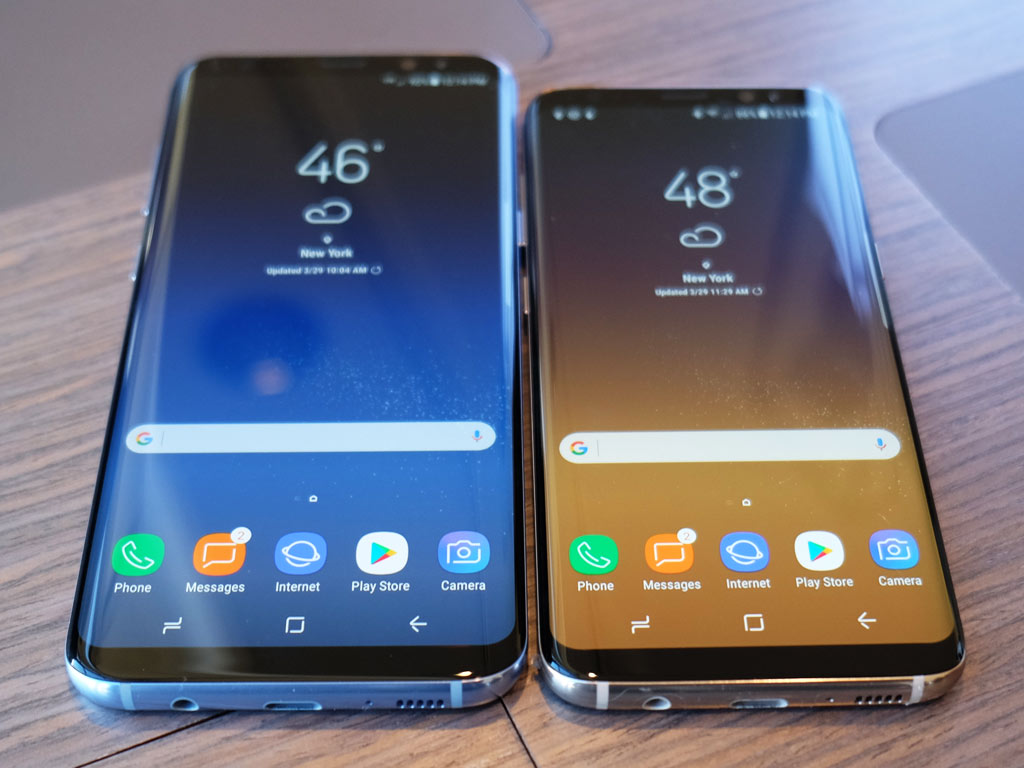
| Samsung Galaxy S8 Display: 5.8-inch 2960 x 1440 AMOLED display with 570 pixels per inchOS: Android 7.0 Nougat Processor: 2.35GHz + 1.9GHz Snapdragon 835 64-bit quad-core processor Memory: 4GB RAM, 64GB (microSD card slot expandable up to 256GB) Camera: 12-megapixel rear camera with optical image stabilization, 8-megapixel front-facing Video: Up to 4K Ultra HD video recording Battery: 3000mAh (non-removable) Connections: LTE, Wi-Fi, Bluetooth 4.2, A-GPS, NFC, Fast Charging, USB-C, Fingerprint sensor, Iris Scanner, Wireless Charging Dimensions: 5.86 x 2.68 x 0.31 inches Weight: 152 grams Comes in midnight black and orchid greySamsung Galaxy S8+ |
Samsung has announced its newest flagship smartphones by unveiling the Galaxy S8 and Galaxy S8+, two similar models that boast bigger screens at the expense of the bezels around them.
Such a design has come with physical changes that make these two phones look considerably different from past models. The home button—a mainstay of Samsung’s mobile devices—is gone, having been replaced by a touch-sensitive button with haptic feedback when pressed. That also relegates the fingerprint sensor to the back panel next to the rear camera.
The larger displays also change the aspect ratio to 18:5:9, translating to more of a rectangular “letterbox” orientation when tilted in landscape mode. What’s happened here is that both phones are only negligibly slimmer on the edges, yet longer vertically. The benefit is each device is easier to hold in one hand, but like any device with a larger display, one-handed operation really depends on how big your hands are.
Feeling the difference
The overall design in both cases sticks to the same basic philosophy where glass adorns both sides, and the edge display has its own interface. The missing physical home button didn’t feel like much of a loss, to be honest, though I would have to get used to the quick launcher for the camera now being moved to the power button on the right edge. The fingerprint sensor being in the back was another change that would take some getting used to.
No doubt noting that move, Samsung included both the iris scanner from the Note 7 (albeit better and faster) and face recognition, both of which can be used individually as a way to unlock from the lock screen. With the regular PIN, pattern and passcode, the company says it has five unique security options for getting past the lock screen.
You still get the headphone jack and USB-C port below. Internal storage is 64GB, with the microSD card slot expanding that up to another 256GB. More than likely, however, you can use higher-capacity cards up to 2TB.
Water-resistance is essentially the same, where you can submerge it down to 1.5 metres for up to 30 minutes. Still, with so much glass, including the curved edges, these are delicate devices. Impact with hard surfaces could be a problem. A case would be a good idea.
Naturally, their respective batteries have garnered attention, and it’s fair to assume there won’t be any fiery surprises here. How long or efficient battery life is, on the other hand, will need to be tested. One interesting tidbit was that Samsung’s excessive battery lab testing has included a claim that they will retain more of their capacity over two years than before in these two devices.
Hello Bixby
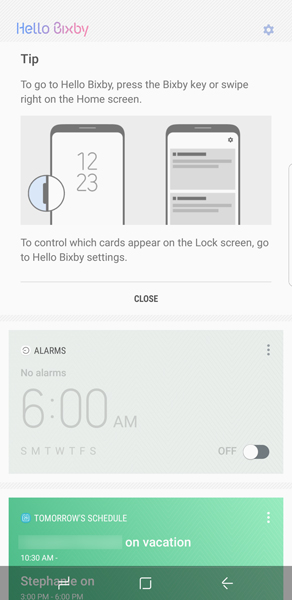 Samsung’s digital assistant was largely focused on the voice elements in the rumour mill leading up to the event, but the truth is that Bixby has been designed with three tenets in mind. As it wasn’t ready to truly test, I couldn’t get a really good sense of what it’s capable of doing off the bat.
Samsung’s digital assistant was largely focused on the voice elements in the rumour mill leading up to the event, but the truth is that Bixby has been designed with three tenets in mind. As it wasn’t ready to truly test, I couldn’t get a really good sense of what it’s capable of doing off the bat.
Samsung says it will be smart enough to understand and interpret both your voice and your habits better over time. The more you use it, the more it caters to you. Hello Bixby is a card-based layout accessible by either swiping right from the home screen or pressing the dedicated button on the left edge to launch it. Here, the cards will be similar to how Google Now presents cards that can include weather, traffic conditions, news, sports scores and more. Integrating other apps adds to it, like a YouTube video, fitness tracking and social media feed, for example.
The Bixby Vision portion uses the phone’s camera to recognize objects and words. It can recognize a product and where to buy it or translate foreign text using Google Translate. Scan QR codes, point out landmarks—this is in the same vein as other attempts in the past from other vendors, so it will be interesting to see if Samsung is able to do it more efficiently.
The Bixby Voice portion was only teased, but there was no real demo or context to draw on, so I can’t be sure just how smart it might be. Samsung was mum on what will or won’t be ready to go when the phones launch in April. The company’s S Voice personal assistant was reportedly used as the foundation. It’s supposed to be a competitor to Siri and Google Assistant. Time will tell.
I should note that Google Assistant is readily available, so if Bixby doesn’t work out, there is another solid option.
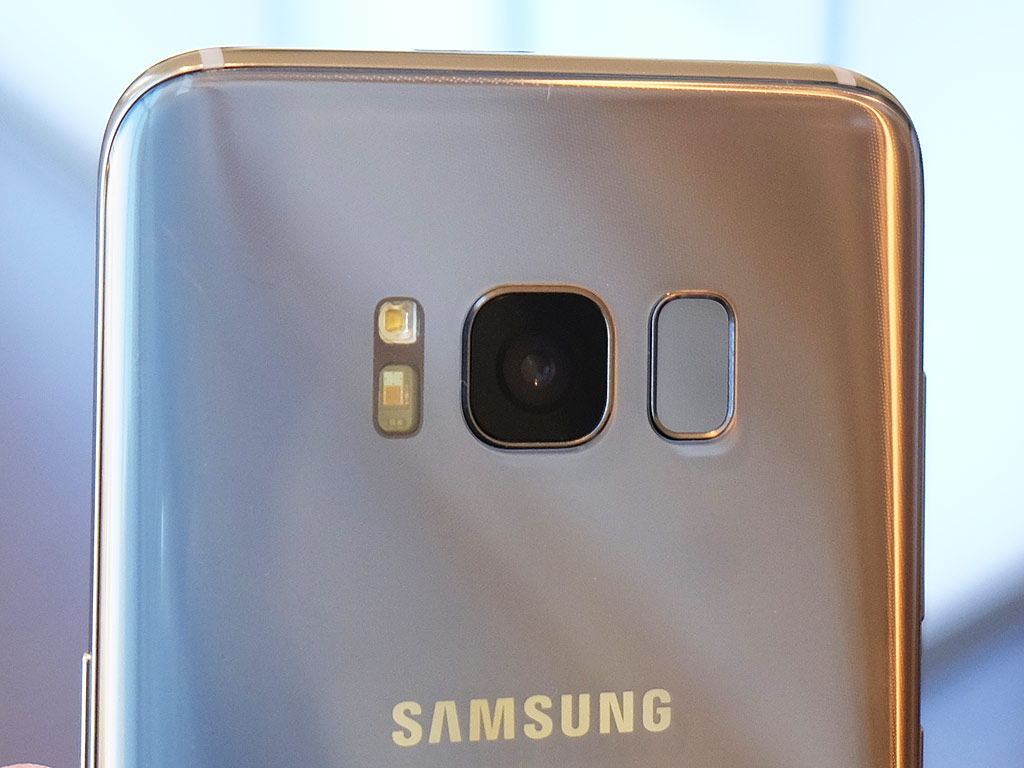
One more thing about the Samsung S8
That Samsung is including AKG earbuds in the box is a nice bonus. The company’s acquisition of parent company Harman allows for such a move, but you can expect it to be a noticeable audio upgrade. At least it should be, but I will have to gauge after testing them out.
The camera appears to me, at least on cursory hands-on use, to be very similar to last year’s models. That’s a good thing because Samsung did an excellent job in producing an effective all-around shooter. I’ll need to test it more thoroughly to see how well it stands up to tougher competition.
Along with the two handsets, accessories were also unveiled. A new Gear 360 that is noticeably smaller than the original. A new Gear VR headset paired with a dedicated controller. And the DeX, a docking station that enables the phone to work with a desktop monitor, keyboard and mouse.
The Samsung Galaxy S8 and Galaxy S8+ are available for pre-order now. Cases and screen protectors for both will also be available by the time they launch on April 21.

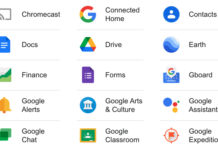
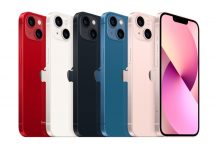

Ted did you ever test a cell phone with 2 different speakers like Dale above says can be done.
Hi,i won’t no the price for sumsung galax
Hi,i won’t no the price for sumsung galax S 8
One mistake here is that it actually has Bluetooth 5.0, not 4.2, which allows connection of 2 devices simultaneously, like 2 bluetooth speakers.
Also, they have announced that Bixby will not be available at launch…not ready yet.
Hopefully everything else will work properly…it really needs to this time!
Comments are closed.